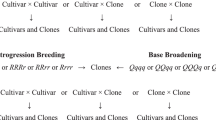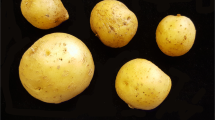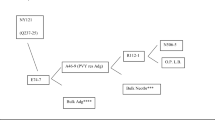Summary
The topiary gene, a single recessive conditioning very short stolons and early tuber initiation, may provide a tool for selecting wild species for tuberization. Topiary segregants may be recognized at the seedling stage, and there is good expression in interspecific hybrids. A genetically diverse diploid population, composed of accessions of 22 species selected for disease resistance and 2n gametes and crossed with sources of the topiary gene, is being developed. Recurrent phenotypic selection for yield and carliness of tuberization will be facilitated by the topiary trait, insect pollination and the self-incompatibility system. Standard varietal evaluation techniques including yield trials, sequential harvests, and tuber quality assessments can be applied to the population to alter gene frequencies or identify suitable parents for crossing to Tuberosum. Selected clones may be maintained in the field without clonal mixture. The population should retain most of the simply inherited disease resistance characteristics present in the original introductions. Adapted germplasm produced by this method should be especially valuable where the number of backcrosses to Tuberosum is to be minimized, as in the improvement of potatoes for quantitative traits such as yield, polygenic disease resistance, and environmental tolerance. Well-adapted clones may contribute a maximum input of genetic diversity through hybridization with Tuberosum haploids and subsequent polyploidization via 2n gametes.
Similar content being viewed by others
References
Falconer, D. S., 1960. Introduction to quantative genetics. Ronald Press Company, New York. pp 301–311.
Glendinning, D. R., 1975. Neo-Tuberosum: new potato breeding material. 2 A comparison of Neo-Tuberosum with unselected Andigena and with Tuberosum. Potato Res. 18: 343–350.
Hanneman, R. E., Jr., 1979. Thoughts on the adaptation of wild species of the potato to the north temperate region. Report to NCR-84 Potato Genetics Technical Committee.
Hawkes, J. G., 1958. Significance of wild species and primitive forms for potato breeding. Euphytica 7: 257–270.
Haynes, F. L., 1972. The use of cultivated diploid Solanum species in potato breeding. In: Prospects for the potato in the developing world. pp. 100-110.
Hougas, R. W. & R. W.Ross, 1956. The use of foreign introductions in breeding American potato varieties. Am. Potato J. 33: 328–339.
Leue, E. F., 1980. Production and evaluation of Tuberosum haploid × wild species hybrids. Report to NCR-84 Potato Geneties Technical Committee.
Leue, E. F. & S. J.Peloquin, 1980. Selection for 2n gametes and tuberization in Solanum chacoense. Am. Potato J. 57: 189–195.
Mendiburu, A. O. & S. J.Peloquin, 1979. Gene-centromere mapping by 4x×2x matings in potatoes. Theor. Appl. Genet. 54: 177–180.
Mendiburu, A. O., S. J.Peloquin & D. W. S.Mok, 1974. Potato breeding with haploids and 2n gametes. In: K.Kasha (Ed.), Haploids in higher plants. Univ. Guelph, Guelph, Canada. pp. 249–258.
Mok, D. W. S. & S. J.Peloquin, 1975. Breeding value of 2n pollen in tetraploid × diploid crosses in potatoes. Theor. Appl. Genet. 46: 307–314.
Nijs, T. P. M.den, E. F.Leue & S. J.Peloquin, 1980. Topiary, a mutant character in Solanum infundibuliforme. J. Hered. 71: 57–60.
Oppong, A., 1981. The occurrence and frequency of 2n gametes in Solanum species from Peru and Bolivia in relation to polyploid evolution and germplasm transfer. Ph. D. Thesis, University of Wisconsin, Madison, Wisconsin.
Rasco, E. T.Jr., R. L.Plaisted & E. E.Ewing, 1980. Photoperiod response and earliness of S. tuberosum ssp. andigena after six cycles of recurrent selection for adaptation to long days. Am. Potato J. 57: 435–447.
Ross, H., 1966. The use of wild Solanum species in German potato breeding of the past and today. Am. Potato J. 43: 63–80.
Ross, H., 1979. Wild species and primitive cultivars as ancestors of potato varieties. Proc. Conf. Broadening Genet. Base Crops, Wageningen. Pudoc, Wageningen. pp. 237–244.
Ross, R. W. & P. R. Rowe, 1969. Inventory of tuber-bearing Solanum species. Bulletin 533. University of Wisconsin.
Author information
Authors and Affiliations
Additional information
Paper No. 2486 from the Laboratory of Genetics. Research supported by the College of Agricultural and Life Sciences; International Potato Center; SEA, USDA, CRGO5901-0410-8-0180-0; and Frito-Lay, Inc.
Rights and permissions
About this article
Cite this article
Leue, E.F., Peloquin, S.J. The use of the topiary gene in adapting Solanum germplasm for potato improvement. Euphytica 31, 65–72 (1982). https://doi.org/10.1007/BF00028307
Received:
Issue Date:
DOI: https://doi.org/10.1007/BF00028307




